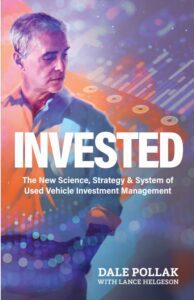I’ve run into a consistent theme in recent conversations with dealers: What do you make of systems that automatically price used vehicles?
The question has also led to requests that we change  ProfitTime GPS from its current functionality of providing recommended price ranges for individual vehicles to automatically pricing each car. When I ask why someone would want to do that, the response boils down to this: “I want to take pricing out of the hands of our people.”
ProfitTime GPS from its current functionality of providing recommended price ranges for individual vehicles to automatically pricing each car. When I ask why someone would want to do that, the response boils down to this: “I want to take pricing out of the hands of our people.”
The frequency of the conversation topic, and the availability of automated pricing tools for dealers, spurred me to share three points to explain why I believe automated used vehicle pricing is, and probably will be for some time, an idea that sounds good in theory, but falls far too short in practice.
Point 1: If I were a dealer considering an automated used vehicle pricing system, I’d want to know exactly how it supports my primary objective of making more money, or net profit, in my used vehicle department. I’d also want to know how the system can adjust, in mid-month or even more frequently, as my goals to drive gross or volume change.
Through my experience with vAuto’s data science team to develop ProfitTime GPS, I’ve come to understand that the best place to drive net profit for the used vehicle department is to determine an ROI-based pricing strategy at the unit level. That’s because a) every vehicle’s investment value is unique; and b) pricing is the primary lever to pull or push to advance a dealer’s short-term objective to go for gross or volume.
To determine the most-optimal ROI-based pricing strategy for every vehicle, you must first know each vehicle’s risk/reward profile. Next, you need to calculate and calibrate a price for a vehicle that delivers the greatest probability of a sale that will achieve the highest ROI. From my familiarity with the data science and AI-based machine learning that powers ProfitTime GPS, I know it’s possible to crack the code of determining the specific factors, in proper weighting, that determine a used vehicle’s investment or ROI potential. But I’m not so sure any automated pricing system can adjust, on a car-by-car basis, when a dealer calls an audible and establishes an objective to drive gross or volume in a particular month, or even more frequently.
That’s why we built ProfitTime GPS to provide ROI-based recommended price ranges, rather than automated prices, for each vehicle. With ProfitTime GPS’ investment score and recommended pricing range, an individual can easily discern the earners and turners in an inventory and adjust prices on the vehicles that best support a dealer’s short-term gross or volume objective. In this way, ProfitTime GPS always serves a dealer’s primary objective to optimize the net profit or ROI for the department, by ensuring each vehicle bears a price that delivers the greatest probability of achieving the highest ROI.
Point 2: With an automated system, you’re pricing with your eyes closed. When dealers suggest they want to take pricing out of the hands of their people, I push back: “Our data’s not that good. Nobody’s data is that good.”
To explain, I highlight the myriad of circumstances that shape a vehicle’s value in the market and today’s technology and tools can’t readily see. You might have a vehicle with a clean CARFAX report and faded paint. You might have a vehicle with worn carpet or seats. You might have vehicle with dents and dings. You might have a vehicle with a tick in the engine, or a hitch in the transmission.
The take-away here is that today’s technology and tools can’t see everything that shapes a vehicle’s appeal, and value, to a potential buyer and the broader market. That’s why you should have a person in charge of pricing who’s got the requisite amount of experience and judgement to put proper eyes, ears and nose on every car. In the absence of human oversight, I question whether an automated system can properly price any vehicle. It seems like you’d be pricing vehicles with your eyes closed, blind to the subjective factors that influence a vehicle’s potential to sell in your market. To be sure, we may see a day when a computer-based system, armed with all the AI-powered technology available, can accurately and properly put “eyes” on a vehicle. But my sense is we’re not there yet.
Point 3: Automated pricing systems remove accountability. The whole point of having an individual in charge of used vehicles and their pricing is to ensure someone’s ultimately accountable and responsible for the outcomes of the used vehicle department. If you’ve got a system automatically pricing your vehicles, you run the risk of ending up in a situation like this:
Dealer: “Hey Joe, our used vehicle gross and volume are way off this month and even worse than last month. Plus, we’ve got a ton of aged cars. What are you doing?”
Used vehicle manager Joe: “Sorry, Boss. Don’t look at me. I didn’t make those decisions.”
As a general rule, dealers don’t like it when they feel the need to hold someone accountable and can’t rightly do it. If such situations occur, you can bet dealers will put the blame for the poor outcomes on the automated pricing system and the vendor who provides it.
I’d add a final observation that’s relevant to this discussion: AI-powered systems and tools are becoming more and more prevalent. Such is the nature of our technology-driven society. But if you look at aviation, finance, healthcare, shipping and other industries where AI tools now drive daily workflows, they all share a common characteristic—there’s usually a person keeping an eye on the AI.
The post Three Reasons Automated Used Vehicle Pricing is a Bad Idea appeared first on Dale Pollak.





